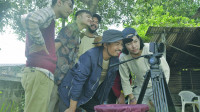Entertainment
This duo uses haunting music and playful projections to talk about endangered animals
Accompanied by the ethereal vocals of Marta del Grandi, Cecilia Valagussa’s animal projections play across the Patan Museum wall, darting left and right. A pangolin is captured in a net by a man and then carted off on the back of a truck.
Sachitra Gurung
Accompanied by the ethereal vocals of Marta del Grandi, Cecilia Valagussa’s animal projections play across the Patan Museum wall, darting left and right. A pangolin is captured in a net by a man and then carted off on the back of a truck. Cecilia manipulates her animals deftly, shifting paper cutouts expertly on the projection table. All the while, Marta sings, her voice following the travails of the poor little pangolin.
The pangolin, or salak, is an endangered species that is especially prone to poaching and smuggling as its hide, skin and meat are prized, especially in China. Not many in Nepal know about this scaly little mammal, even though it is found in 43 of Nepal’s districts. Marta Del Grandi and Cecilia Valagussa are trying to change this, through their collaborative art and education enterprise, the Fossick Project.
Marta and Cecilia, who are both Italian, met in 2013 in Brussels, Belgium while they were pursuing their graduate degrees. Marta studied Jazz at the Royal Conservatory of Brussels and Cecilia graduated from Sint-Lukas with a degree in comics and illustration. The two might have had different backgrounds but they shared a passion for the arts and decided to collaborate.
For one of Cecilia’s art book projects, the two decided to use Marta’s music alongside Cecilia’s art. Armed with an overhead projector, Cecilia produced cutouts of her art and Marta began to sing. What started out as an experiment ended up becoming The Fossick Project.

The pangolin performance, entitled ‘Long tong tales—A Journey into the world of pangolins’, was their first complete performance since they decided to focus on raising awareness about endangered species, along with wildlife and environment conservation. They believe that the best way to change things is to talk about it and that art is the perfect medium to do it.
“I am very inspired by animal sounds,” says Marta, whose music makes creative use of various natural, vocal and musical samples.
“And I love drawing animals. I have been drawing them for as long as I can remember,” says Cecilia.
Since both of their works have a strong affinity to animals and they identify themselves as environmentalists, they decided to make endangered species the protagonist of their art. As a singer-songwriter, Marta usually composes music inspired by Cecilia’s art whereas Cecilia makes images, puppets, paintings and anything else that could fit into the performance. Everything is made from scratch.
“We are spreading awareness in a poetic and artistic way with the combination of sound and visuals,” says Cecilia. “We want our audience to resonate, understand the message that we are trying to convey and take action.”
Apart from regular performances in Kathmandu, the Fossick Project has also been conducting workshops for children, after getting invitations from a number of teachers who saw them perform. They designed an interactive workshop about endangered animals and the environment for children from The Lincoln School and The French School. Earlier this month, they collaborated with the Children’s
Art Museum (CAM) to conduct a workshop for students from the Janak Nath Memorial Secondary School and Adarsha Yog Hari Madhyamik Vidyalaya.
“In these workshops, we teach children about endangered animals and tell their stories. Then the kids draw and Cecilia helps them make puppets. I teach them the sounds of different animals, write rhymes about animals and in the end, we have a funny song and story about animals and the environment,” says Marta.
Cecilia and Marta want to bring their work to more children from all socioeconomic backgrounds as they understand that underprivileged kids aren’t often exposed to projects such as their since they don’t have enough resources. For the workshop with Janak Nath and Adarsha Yog schools, the Fossick Project received support from the Consulate of Italy in Nepal.
The word ‘fossick’ in Australia and New Zealand means ‘to search’, and true to its name, the Project is always exploring different stories and different places. They try to connect to traditions and roots. In India, Marta was inspired by the local music and Cecilia by the architecture. Everything they do, they try to connect to a specific place and tell that specific story. In the future, Marta and Cecilia want to travel so that they can bring together stories from different places.
This year, they are focussing on the Great Indian bustard, a species of large terrestrial bird that was once found across India and Pakistan but is now critically endangered to the point that there are less than 200 of them left in the wild. In their visit to the Thar desert in Rajasthan, Marta and Cecilia discovered that people living in the bird’s current habitat don’t know its protection status and that there are so few of them left. If neglected, the bustard will probably become extinct in the next 10 years or less. So their latest project, premiering today, is called ‘The great giant leap’ and its star is the Great Indian bustard.
“What we do is we tell a story and it’s entertaining and amusing but it is also very touching,” says Marta. “It’s a performance for the audience to enjoy but at the end of day, it’s all about the message that we want to shed light on and that is to conserve the environment. Everyone working towards this in their own spaces is how the change will start.”
The Fossick Project will be premiering The Great Giant Leap at Yala Maya Kendra, Patan, on March 23, 6.30pm. Tickets are Rs 500




 21.36°C Kathmandu
21.36°C Kathmandu











